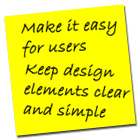
The title of this subsection is the title of Krug’s book (2000), which is an excellent resource for novice designers. There are a number of common sense items that fall under this category.
- General Layout
Make titles and headlines so that they accurately describe the material on a page. Organize content in a neat, logical order. Make pages clear and orderly. Be brief, if possible.
- Buttons
If they are meant to be used, make their intended use obvious. Don’t use button titles that are long. If it’s a search button, call it “Search.” If the button is used to send e-mail, call it “Send.”
- Search Features
If there are too many pull-down menus or the features are ultra-complex, users will become confused by it. Instead, offer a simple search feature with an input box and a “Search” button. Place a more complicated search feature on the search results page for users who want more detailed results.
Make the site self-evident. Krug (2000) warns designers to reflect on this else suffer the consequences. What are the consequences? Users can easily become frustrated. When they feel this emotion on a site, it is likely that these users will exit and find some other site that is less frustrating. If the intended goal was to instruct users, users will not be able to digest the information and make any progress within the curriculum.